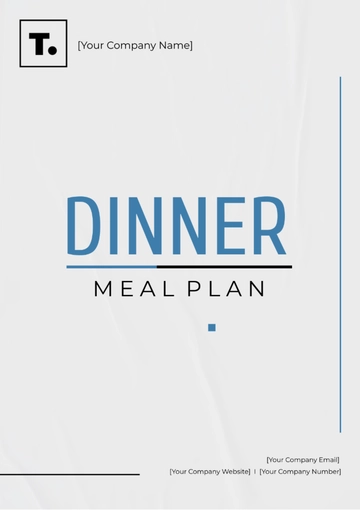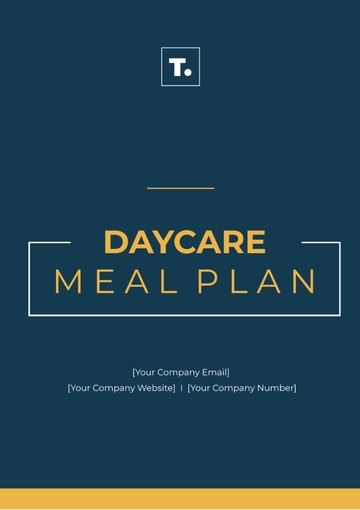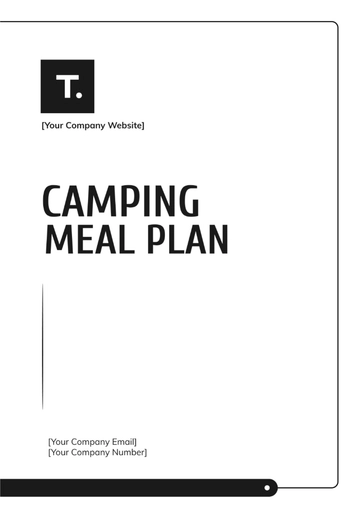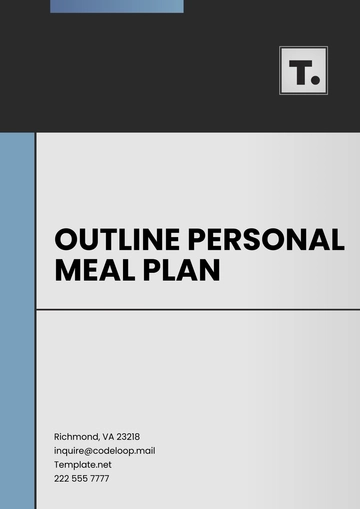Free Meal Planning

I. Introduction to Meal Planning
A. Importance of Meal Planning
Meal planning is an essential practice for maintaining a healthy lifestyle. By organizing your meals ahead of time, you can ensure balanced nutrition, save time, and avoid the temptation of unhealthy options. At [Your Company Name], we believe that thoughtful meal planning is the key to meeting both your fitness and health goals.
B. Goals of Meal Planning
The primary goal of meal planning is to create a sustainable routine that promotes optimal health. Whether you’re focusing on weight management, muscle building, or just a healthier lifestyle, a structured meal plan will help you stay on track. We tailor each plan to fit your unique needs and preferences, ensuring you get the most out of every meal.
C. Overview of Meal Frequency and Timing
Meal frequency and timing are important factors in maintaining energy levels and supporting metabolism. Our recommended approach typically involves three main meals and two snacks daily, spaced to keep hunger at bay. This structure allows for balanced nutrient intake and provides steady energy throughout the day.
II. Nutritional Foundations
A. Macronutrients
Carbohydrates
Carbs are the body’s main source of energy. Opt for complex carbohydrates such as whole grains, fruits, and vegetables for sustained energy. They also provide essential fiber, which aids digestion and keeps you feeling fuller longer.
Protein
Protein is essential for muscle repair and growth. Include lean proteins like chicken, turkey, fish, and plant-based options like beans and tofu to support your fitness goals. Protein also helps in managing hunger and boosting metabolism.
Fats
Healthy fats are necessary for hormone production and nutrient absorption. Include sources like avocados, olive oil, and nuts to maintain a healthy balance. Omega-3 fatty acids from fatty fish like salmon are especially important for heart health.
B. Micronutrients
Vitamins
Vitamins A, C, D, and E are key for immunity, skin health, and bone strength. Include foods like citrus fruits, leafy greens, and fortified dairy products to cover your vitamin needs.
Minerals
Essential minerals such as calcium, magnesium, and iron play vital roles in bone health, energy production, and muscle function. Incorporate foods like spinach, almonds, and beans for optimal mineral intake.
Phytonutrients
Phytonutrients, found in fruits and vegetables, act as antioxidants, reducing inflammation and supporting overall health. Be sure to include a variety of colorful produce, such as berries, peppers, and tomatoes.
C. Hydration
Importance of Water
Proper hydration is crucial for digestion, joint function, and skin health. Aim to drink at least eight cups of water daily, adjusting for activity level and climate.
Hydrating Foods
In addition to drinking water, hydrating foods like cucumbers, watermelon, and celery provide extra moisture to keep you hydrated.
Hydration Strategies for Active Individuals
If you’re engaging in intense physical activity, ensure you replenish electrolytes with sports drinks or coconut water. Stay ahead of thirst to avoid dehydration and fatigue.
III. Personalized Dietary Considerations
A. Special Diets
If you follow a specific dietary regimen, such as vegan, keto, or gluten-free, we customize meal plans that meet those needs. For example, a vegan meal plan may focus on plant-based protein sources, while a keto plan reduces carbs and increases healthy fats. Tailored diets can help support overall well-being and ensure you get the nutrients your body needs.
B. Food Allergies and Intolerances
We take food allergies and intolerances seriously. If you have sensitivities to gluten, dairy, nuts, or any other ingredient, we ensure those are excluded from your meal plan. Our plans are designed to be both delicious and safe, ensuring you enjoy every bite without worry.
C. Tailoring Meals to Personal Health Conditions
If you have a specific health condition such as diabetes or high cholesterol, your meal plan will include foods that support these health challenges. For instance, a diabetes-friendly meal plan focuses on low glycemic index foods and balanced protein-carbohydrate ratios. We also ensure that each meal supports heart health and manages blood sugar levels.
IV. Meal Categories and Balanced Options
A. Breakfast
Protein-rich Breakfast | Start your day with a high-protein breakfast such as scrambled eggs with spinach and avocado. This helps with muscle repair and keeps you feeling full until lunch. |
Fiber-filled Choices | Oatmeal with chia seeds and berries provides a great source of fiber to support digestion and keep you energized. |
Quick and Easy Options | A smoothie made with protein powder, almond milk, and frozen fruit is a great option for busy mornings. |
B. Lunch
Lean Protein-Based Lunches | A grilled chicken salad with mixed greens, quinoa, and olive oil dressing provides lean protein and healthy fats. |
Incorporating Complex Carbs | A quinoa bowl with black beans, avocado, and grilled veggies ensures a perfect balance of carbs, protein, and fiber. |
Fresh Salad Options | Try a Mediterranean-inspired salad with chickpeas, feta cheese, cucumbers, and tomatoes, drizzled with a lemon vinaigrette. |
C. Dinner
Light but Filling Meals | Baked salmon with steamed broccoli and roasted sweet potatoes is a nutrient-dense option that’s light yet satisfying. |
Seafood and Poultry | Grilled shrimp with sautéed spinach and quinoa offers lean protein and healthy fats. |
Low-Carb Meals | Stir-fried tofu with zucchini noodles and a sesame dressing is a perfect low-carb, plant-based dinner. |
D. Snacks
Healthy, Satisfying Snacks | A handful of almonds and an apple make for a quick, nutritious snack. |
Energy-Boosting Ideas | Greek yogurt with chia seeds provides protein and fiber for sustained energy throughout the afternoon. |
Protein-Packed Snacks | Hummus with carrot sticks or cucumber slices offers a balance of protein, healthy fats, and fiber. |
E. Desserts
Low-Sugar Alternatives | Try a chia pudding made with almond milk and topped with fresh strawberries for a sweet yet healthy treat. |
Fruit-Based Desserts | A fruit salad with a mix of berries, kiwi, and a drizzle of honey offers a refreshing and natural dessert option. |
Portion-Controlled Options | A small piece of dark chocolate with almonds is a satisfying and healthy way to end the day. |
V. Sample Meal Plan for the Week
Day | Breakfast | Lunch | Dinner | Snack 1 | Snack 2 |
|---|---|---|---|---|---|
Monday | Scrambled eggs with spinach and avocado | Grilled chicken quinoa bowl | Salmon with roasted vegetables | Greek yogurt with chia seeds | Apple with almond butter |
Tuesday | Smoothie with protein powder, spinach, and almond milk | Turkey and veggie wrap | Stir-fried tofu with brown rice | Hard-boiled eggs, carrot sticks | Cottage cheese with cucumber |
Wednesday | Overnight oats with chia seeds and almond butter | Lentil salad with mixed greens | Baked cod with sweet potato fries | Almonds and an orange | Rice cakes with almond butter |
Thursday | Avocado toast with poached eggs | Quinoa bowl with black beans, avocado, and veggies | Grilled shrimp with sautéed spinach | Hummus with carrot sticks | Mixed nuts |
Friday | Veggie omelette with tomatoes and mushrooms | Mediterranean salad with chickpeas, feta, and cucumbers | Grilled chicken with steamed broccoli | Greek yogurt with berries | Sliced apple with peanut butter |
VI. Shopping List and Grocery Essentials
A. Proteins |
|
B. Vegetables and Greens |
|
C. Grains and Legumes |
|
D. Healthy Fats |
|
VII. Meal Prep Strategies
A. Batch Cooking
Batch cooking allows you to prepare larger quantities of ingredients at once, making weekday meals quicker and more convenient. For example, cooking a large batch of grilled chicken or quinoa and storing it in the fridge can save you time throughout the week and ensure you always have healthy options on hand.
B. Time-Saving Tips
Maximize your time by preparing meals in advance, such as chopping vegetables, marinating proteins, or cooking grains. To make the process even more efficient, try multitasking—roast vegetables while boiling rice, or cook multiple servings of chicken at once.
C. Proper Storage and Organization
Invest in clear, stackable containers to store prepared meals and ingredients. Label each container with the contents and date so you can easily track freshness and reduce food waste, and ensure that your refrigerator is organized to make grabbing ingredients quick and easy.
VIII. Tracking and Adjusting the Plan
A. Monitoring Progress
Consider maintaining a detailed food journal or utilizing a meal tracking application to meticulously record all the meals you consume and to evaluate how various types of food affect your feelings throughout the day. By diligently tracking your meals, you can uncover specific patterns and make informed adjustments to your eating habits. This approach empowers you to enhance your energy levels and mood while also advancing steadily toward achieving your personal health objectives.
B. Fine-Tuning for Specific Goals
As your goals evolve, revisit your meal plan to ensure it's aligned with your current needs. For instance, if you’re shifting from a weight-loss phase to muscle gain, you might want to increase protein intake and adjust caloric intake while keeping track of your macronutrient ratios.
C. Avoiding Pitfalls
To avoid slipping back into unhealthy eating habits, focus on the long-term benefits of your meal plan and remind yourself of your goals regularly. If you find yourself struggling with cravings, incorporate more nutrient-dense snacks into your plan to curb hunger without sabotaging your progress.
IX. Sustainability and Long-Term Success
A. Building Healthy Habits
To begin, try introducing one or two modifications into your daily routine; for instance, you might consider preparing meals in advance once per week or slowly decreasing your consumption of processed foods. By cultivating habits that align with and support your personal objectives, you position yourself for enduring success while avoiding the feeling of being overwhelmed.
B. Adapting to Changing Needs
As your lifestyle and health goals evolve, it’s important to adjust your meal plan accordingly. Whether you’re increasing your physical activity, managing a new health condition, or working toward a new fitness goal, make sure your meals support your body’s changing needs.
C. Staying Motivated
Maintaining a high level of motivation can prove to be quite difficult, yet discovering methods to make your meals enjoyable is essential to success. Consider the idea of exploring new recipes, engaging in meal preparation with friends or family, and taking the time to celebrate small victories. By doing so, you can significantly enhance your ability to stay committed with strength and consistency over time.
- 100% Customizable, free editor
- Access 1 Million+ Templates, photo’s & graphics
- Download or share as a template
- Click and replace photos, graphics, text, backgrounds
- Resize, crop, AI write & more
- Access advanced editor
Organize your meals effortlessly with the Meal Planning Template from Template.net. This editable and fully customizable tool allows you to tailor your meal plans to fit your needs. With the intuitive AI Editor Tool, you can easily adjust the template for any dietary preferences or schedules. Make meal planning simple, efficient, and personalized!





























